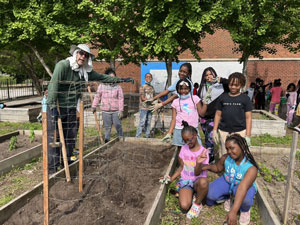
By Deborah Rogers Curtis, Green Schools Coordinator for the Missouri Gateway Green Building Council
School gardens are becoming more common across the United States as teachers look for hands-on learning opportunities for their students. Gardens provide an incredible number of benefits, but they also come with challenges. One of the most significant issues is that the growing season does not necessarily coincide with the school year’s calendar. How can schools ensure they harvest their produce responsibly and care for their gardens when everyone is out of school for summer break?
Tip 1: Make the School Garden a Community Garden
Create an asset map of the residents, businesses, churches, or non-profits in the school community in order to build partnerships to help care for the garden collectively. Local residents and companies are inherently invested in seeing a beautiful, well-kept garden that produces a healthy harvest for the neighborhood to enjoy. Creating a water/weeding/harvesting schedule for community partners allows a specific way for them to give back to their local school, and also allows the garden to become a multi-generational community garden.
Tip 2: Provide Perks for a Staff Member Willing to Monitor the Garden over the Summer
While a financial stipend would be ideal, it is usually not in the school’s budget to pay a staff member over the summer to monitor the garden. Other perks that might entice a staff member to care for the garden include extra days off during the school year, a preferred parking space, the freedom to design a garden class during the school year, or supplies for the garden.
Tip 3: Create a Summer Student Club or Internship
A summer club or internship for the students to care for their garden would provide an extracurricular activity, real-world learning experience, and a sense of responsibility for all those involved.
Tip 4: Choose Summer-Specific Plants
By carefully selecting the types of seeds or plants that are planted for the summer growing season, school gardeners can avoid plants that require a large amount of water. Native plants are not only great for pollinator gardens and combating climate change, they also are well adapted to the region and do not require extra watering.
Tip 5: Allow Garden Beds to Rest
Using weed cover or even cardboard to prevent and control weeds growing over the summer can allow school garden beds to rest over the summer months. This will also set the school up for a successful fall planting and harvesting season when students and staff return to school.
For more information on school gardens and sustainability initiatives, visit showmegreenschools.org.


